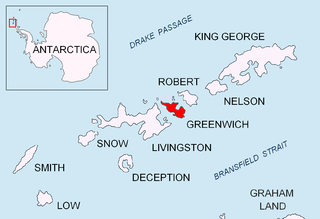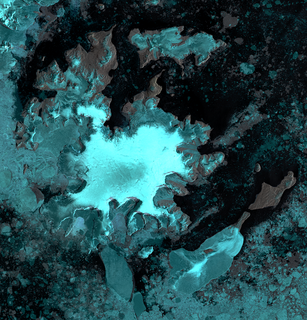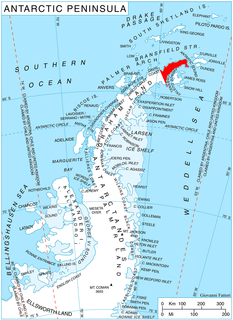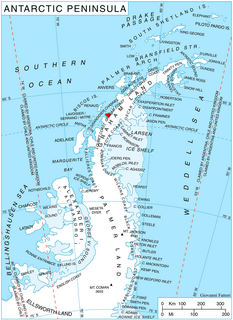
The Arctic Archipelago, also known as the Canadian Arctic Archipelago, is a group of islands north of the Canadian mainland.

Arthur Harbour is a small harbour entered between Bonaparte Point and Norsel Point on the south-west coast of Anvers Island in the Palmer Archipelago of Antarctica.
The Stepping Stones are three prominent rocks lying 0.8 km (0.5 mi) north of Limitrophe Island, off the southwest coast of Anvers Island, Antarctica. The Stepping Stones are located at 64°47′S64°00′W. The Stepping Stones form one of a series of small boat refuges for parties working between nearby Palmer Station and Biscoe Bay, and therefore form "stepping stones" for coastal trips. Named by Palmer Station personnel in 1972.
Merville is an unincorporated community in the Comox Valley between the City of Courtenay, Mount Washington, Dove Creek, and Black Creek near the east coast of Vancouver Island. It was named by soldiers returning to the Island after fighting in France for Canada in World War I.
The French Antarctic Expedition is any of several French expeditions in Antarctica.
Quilp Rock is a small, isolated rock in Laubeuf Fjord, lying 6.5 kilometres (3.5 nmi) south-southeast of the south tip of Pinero Island and 2.4 kilometres (1.3 nmi) off the northwest side of Pourquoi Pas Island, off the west coast of Graham Land. First surveyed in 1948 by the Falkland Islands Dependencies Survey (FIDS), it was named by them after the dwarf, Daniel Quilp, a vicious, ill-tempered character in The Old Curiosity Shop, by Charles Dickens.

The Ibar Rocks are two rocks located 0.4 kilometres (0.2 nmi) east of Bonert Rock and 1 kilometre (0.6 nmi) southeast of Canto Point, Greenwich Island, in the South Shetland Islands. The names "Islote Ibar" and "Islote Teniente Ibar" appearing on Chilean hydrographic charts in the 1950s refer to the larger and western rock. The recommended name "Ibar Rocks" includes a submerged outlier to the northeast of the larger rock. Teniente (lieutenant) Mario Ibar P. signed the official act of inauguration of the Chilean Captain Arturo Prat Base on Greenwich Island in 1947.

Ineson Glacier is a glacier flowing northwest into Gin Cove, James Ross Island, Antarctica. Following geological work by the British Antarctic Survey (BAS), 1981–83, it was named by the UK Antarctic Place-Names Committee after Jonathan R. Ineson, a BAS geologist in the area.
The Andrews Rocks are a small group of rocks 0.5 nautical miles (1 km) east of Cape Paryadin, South Georgia. The rocks are bare of vegetation and awash in heavy seas. The name "Andrews Islands" was probably given by Lieutenant Commander J.M. Chaplin, Royal Navy, of the RRS Discovery during his survey of the area in 1926. The South Georgia Survey, 1955–56, reported that "rocks" is a more suitable descriptive term for this group.

Aphrodite Glacier is a glacier 15 nautical miles (28 km) long flowing north to the east coast of the Antarctic Peninsula 3 nautical miles (6 km) west of Victory Nunatak. The lower portion of the feature was first plotted by W.L.G. Joerg from aerial photographs taken by Sir Hubert Wilkins in December 1928 and by Lincoln Ellsworth in November 1935. The glacier was subsequently photographed by the Ronne Antarctic Research Expedition in December 1947 and surveyed by the Falkland Islands Dependencies Survey in December 1958 and November 1960. It was named by the UK Antarctic Place-Names Committee after Aphrodite, the goddess of love in Greek mythology.

Boydell Glacier is a glacier on Trinity Peninsula in northern Graham Land. It is about 9 miles (14 km) long, flowing southeastward from Detroit Plateau to enter Sjögren Inlet in Prince Gustav Channel north of the terminus of Sjögren Glacier and 6 miles (10 km) west of Mount Wild. It was mapped by the Falkland Islands Dependencies Survey from surveys (1960–61), and named by the UK Antarctic Place-Names Committee for James Boydell, English inventor of a steam traction engine, the first practical track-laying vehicle.
Breakwater Island is a small island in the Palmer Archipelago with a line of rocks extending in a southwest arc from it, lying opposite Nipple Peak, 0.3 nautical miles (0.6 km) off the east side of Wiencke Island. The descriptive name, suggestive of an artificial breakwater, was given by the Falkland Islands Dependencies Survey in 1944.
Buddha Rock is a rock, 35 metres (115 ft) high, lying 0.3 nautical miles (0.6 km) west of Vindication Island in the South Sandwich Islands. It was charted and named in 1930 by Discovery Investigations personnel on the RSS Discovery II.

Channel Glacier is a through glacier, 1.5 nautical miles (3 km), extending in an east-west direction across Wiencke Island, between Nipple Peak and Wall Range, in the Palmer Archipelago. It was discovered by the Belgian Antarctic Expedition under Gerlache 1897–99. The name appears on a chart based on a 1927 survey by DI personnel on the Discovery.

Montgolfier Glacier is a glacier situated between Rozier Glacier and Woodbury Glacier and flowing between Balis Ridge and Bacho Kiro Peak into Piccard Cove on the west coast of Graham Land, Antarctica.
The Haller Rocks are a small group of rocks in the eastern part of Bouquet Bay, lying 2 nautical miles (4 km) northwest of the southwest end of Liège Island, in the Palmer Archipelago, Antarctica. They were photographed by Hunting Aerosurveys Ltd in 1956–57, and mapped from these photos in 1959. They were named by the UK Antarctic Place-Names Committee for Albrecht von Haller, a Swiss physiologist who made important contributions to medical knowledge, for example, mechanism of heartbeat, action of bile.

The Marshall Archipelago is an extensive group of large ice-covered islands within the Sulzberger Ice Shelf off Antarctica. Several of the islands were discovered and plotted by the Byrd Antarctic Expeditions and by the United States Antarctic Service (1939–41), all led by Admiral Richard E. Byrd. The full extent of the archipelago was mapped by the United States Geological Survey from surveys and U.S. Navy air photos (1959–65). The name was proposed by Admiral Byrd for General of the Army George C. Marshall, who made financial contributions as a private individual and also, on the same basis, provided advisory assistance to the Byrd expedition of 1933–35.

Hoek Glacier is a glacier flowing into Dimitrov Cove northeast of Veshka Point on the northwest coast of Velingrad Peninsula on Graham Coast in Graham Land, Antarctica, southward of the Llanquihue Islands. It was charted by the British Graham Land Expedition under John Rymill, 1934–37, and was named by the UK Antarctic Place-Names Committee in 1959 for Henry W. Hoek (1878–1951), a pioneer Swiss ski-mountaineer and author of one of the earliest skiing manuals.
Knob Point is the southwesternmost point of Vindication Island in the South Sandwich Islands. It was charted in 1930 by Discovery Investigations personnel on the Discovery II, and probably so named because a conspicuous height of land overlooks the point.










